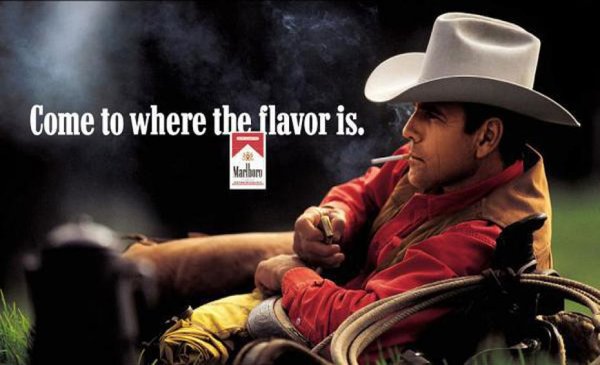
The most famous brand archetype success of all time is also the most documented.
In 1924, Philip Morris introduced Marlboro cigarettes as a brand for women, milder and filtered to contrast with the stronger unfiltered brands smoked by most men. The filter was even printed with a red band to hide lipstick marks. The original tagline for the brand was ‘Mild as May’.
By 1954, the world had changed, and smokers reconsidered their love of unfiltered cigarettes. This led Marlboro to consider how to leverage its safer filtered cigarette to a wider audience, leading to the creation of the ‘Marlboro man’ by Leo Burnett. The iconic image of the Marlboro man led to one of the greatest U-turns in branding history, and was found in response to Leo Burnett’s question, ‘What’s the most masculine symbol that you can think of?’ to which one of his writers said ‘a cowboy’. The ad campaign was launched in 1955 and within two years had increased US sales from 5 billion to 20 billion. Marlboro was the leading global brand by 1972 and is still the number one cigarette brand.
The new image appealed to both men and women, embodying independence, defiance, adventure and authenticity, a combination of Explorer and Rebel, drawing on the mythology of the US Wild West frontier. The imagery taps into human universal themes, creating connections to strongly embedded associations with the American West and the cowboy films and TV shows were popular as the brand grew.
Jerome Bruner wrote that in classic information theory a message is considered informative ‘if it reduces alternative choices’. The power of archetypes is to access elaborate networks of associated memories that come from our cultural as well as personal memories. When these networks are aligned with our individual goals, they help us to close down other choices and focus on the brands that are most mentally available, as long as they are physically available to us at the right time.
The secret to building brand essence is to understand the impact of sense, symbol and story on each customer, and their connection to the customer’s values. Does the sensory experience of the brand provide consistent patterns? Are brand symbols sending the right signals to customers? And does the brand personality tell the right story?
Successful brands build brand experiences, brand symbols and brand stories anchored by archetypes that consistently reflect their core essence.
Contributed to Branding Strategy Insider by: Neil Gains, excerpted from his book, Brand Essense: Using sense, symbol and story to design brand identity, with permission from Kogan Page publishing.
The Blake Project Can Help: The Brand Storytelling Workshop
Branding Strategy Insider is a service of The Blake Project: A strategic brand consultancy specializing in Brand Research, Brand Strategy, Brand Licensing and Brand Education
FREE Publications And Resources For Marketers











